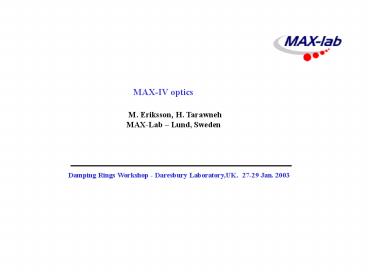MAXIV optics - PowerPoint PPT Presentation
1 / 9
Title:
MAXIV optics
Description:
X-ray ring Soft X-ray ring. Ring circumpherence (m) 285 285 ... V. Sext. 144. 0.1 -2160. MAX-IV magnets. Pole profile for the combined bending magnets ... – PowerPoint PPT presentation
Number of Views:43
Avg rating:3.0/5.0
Title: MAXIV optics
1
MAX-IV optics M. Eriksson, H.
Tarawneh MAX-Lab Lund, Sweden
Damping Rings Workshop - Daresbury Laboratory,UK.
27-29 Jan. 2003
2
MAX-IV Machine Parameters
X-ray ring Soft
X-ray ring Ring circumpherence (m)
285 285
Operating energy (GeV) 3
1.5 Circulating current (A)
0.5
0.5 Rad energy loss/turn (keV)
770 50
Hor emittance (nm rad) 1.1
0.29 Qx
26.6
26.6 Qy
9.6 9.6
Nat. Hor. Chromaticity
-33
-33 Nat. Vert.
Chromaticity -29
-29 Hor. Admittance (?m rad)
17
17 Vert . Admittance (?m rad)
1.25 2.8
Energy acceptance ()
4 4
Nr of straight sections 12
12 Length of
straight section (m) 4.6
4.6 Beam 1/e
lifetime Touschek (h) 18
28.6 El scattering (h)
131
73 Bremsstrahlung (h) 195
195 Total (h)
14.6 18.6
RF (MHz) 100
100 RF Power (kW)
600
200
3
Machine functins
4
Phase Space and Dynamic Aperture -The inclusion
of sextupolar fields reduce the maximum stable
oscillation for the particles (Dynamic
Aperture).
5
Tune Shift -Sextupole fields introduce chromatic
and geometric aberrations. -Sextupole component
in dispersion-free section and Octupole component
were introduced to minimise tune shift with
energy deviation and oscillation amplitude.
6
MAX-IV magnets
7
Pole profile for the combined bending
magnets -The small aperture size allows for
strong multipole magnet. Dipole 1
Dipole 2 Bo 0.9 T
Bo 1.3 T
B 10.5 T/m
B 10.7 T/m
65 mm
65 mm
24 mm
24 mm
8
Pole profile for the combined Quadrupole
magnet -The integrated components are
1- Quadrupole B 27 T/m
2- Sextupole
B 600 T/m2
3- Octupole B 6850 T/m3
26 mm
9
Permanent magnet for the lattice magnets -With
full energy injector, an interesting alternative
is to use permanent magnet. -Rare Earth Cobalt
(SmCo) shows high radiation resistance and
temperture stability (low remanence field
loss).
Dipole magnet median plane































